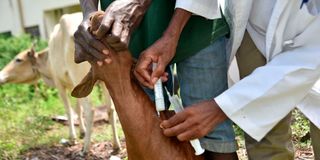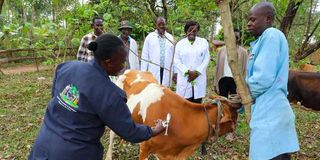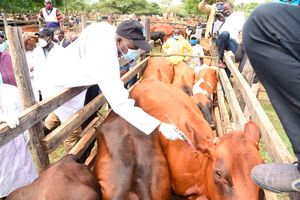
A veterinary officer vaccinates livestock against Anthrax in Mombasa.
Murang’a’s love for meat is best illustrated by Ms Millicent Mugure, 78, from Ndanga village who lost a dairy cow in 2021 to a mysterious illness.
“The veterinary officer I had called to guide me on how to dispose of the carcass recommended that I bury it… not even dogs or cats were to touch the meat,” she recalls.
Honouring that directive, she supervised several neighbours as they buried the cow around 6pm then retreated to her house to mourn the loss of a cow that had been producing 32 litres of milk daily.
Selling each litre at Sh50 in Kabati market, Kandara constituency, her gross daily loss was Sh2,280, which she said was a reason to grieve.
But the young men who had helped bury the cow were mourning for another reason: wasted feasting… and they did something about it.

A veterinary officer vaccinates livestock against Anthrax in Mombasa.
“The following morning, the cow grave was wide open and there was no carcass and I remembered the story of death and resurrection. But this was no miracle. About 50 people fell ill with anthrax-related symptoms after exhuming and feasting on the carcass,” Ms Mugure says.
According to the 2024 County Disease Tracking and Control report, Murang’a has recorded 76 anthrax cases in the past decade resulting in three deaths. In all recorded cases, the chain of infection started with a dead cow that neighbours insisted on eating against expert advice.
According to the 2019 Kenya Market Trust data, the average Kenyan consumes about 15 kilogrammes of meat annually with beef being the most popular followed by chicken, goat, mutton, fish and pork.
Perhaps in their determination to maintain that statistic, many Murang’a residents have consistently refused to bury dead cattle, opting instead to consume them therefore risking anthrax outbreaks.
For Christopher Njata from Kahumbu Ward, the decision was nearly fatal. Last year, two of his grade cows died of anthrax and cost him about Sh300,000. A veterinary officer buried his hopes of recovery when he declared the carcasses unfit for consumption.
But Mr Njata’s neighbours had a suggestion of selling the carcasses cheaply to the locals. He obliged and those who ate the meat fell ill. When village dogs began dying too, Mr Njata feared jail, but authorities spared him.
James Njoroge from Gikingi village in Gatanga constituency saw a similar tragedy unfold. On April 11, 2025, his cow fell sick and died within hours. The vet advised burial but area youths seized the carcass and threatened violence against anyone who tried to stop them.
“Look at it this way... The last time I had enough money to treat my family was in 2018 when I worked as a school watchman for Sh3,000 a month,” said Peter Njogu, 38, one of those who demanded the carcass.
“It’s been my dream to come home carrying goodies for my kids like a real dad. There is this old trick – you first give the meat to your cat. If it eats it, it is safe. My cat ate it so I figured the vet just wanted to deny us a good meal.”.
Today, Njogu’s cat is dead. He, his wife and children are among those under mandatory anthrax treatment by the county government.
Murang’a Health Director, Dr James Mburu, says most victims of anthrax are under 12 years old. “Adults collect the meat and feed it to their children. Thankfully, the county is always ready to respond quickly,” he said.
Murang’a Health Chief Officer Eliud Maina finds the behaviour baffling. “Residents openly admit they know the dangers of eating uninspected meat, but they still say it is difficult to bury meat,’” he said.
Mr Maina said the county is working to enforce a meat traceability policy by empowering health officers to demand proof of meat sources at any gathering.
A February 2024 investigative tour by the Ministry of Health, the Kenya Field Epidemiology and Laboratory Training Program (FELTP) and the Zoonotic Disease Unit (ZDU) assessed Murang’a’s anthrax risk and proposed preventive measures.
“The greatest blessing is that most anthrax cases here are from ingestion, which is more treatable than inhalation – the deadlier form,” Maina noted.
To mitigate the risk, the county has intensified surveillance. Anthrax typically manifests one to 7 days after exposure but in some cases, it may take up to 60 days. Now, the departments of livestock, public health and curative care have been placed under round-the-clock monitoring.
“We have mandated bi-monthly cow vaccinations. But while it’s easy to control locally reared cattle, we are powerless against meat sourced secretly from neighbouring counties or rogue butchers,” Maina said.

Veterinary officers vaccinate a cow against anthrax in Malava Constituency, Kakamega County, on March 20, 2025.
He added that meat is deeply symbolic in local culture sometimes driving residents to absurd extremes.
Currently, the county is responding to a potential anthrax outbreak in Gati-Iguru village, Gatanga constituency, after over 600 residents ate meat from a dead cow. Authorities are also vaccinating 500 cows in the area.
Murang’a County Commissioner Joshua Nkanatha blames a mix of old traditions and a reckless appetite for the recurring anthrax cases.
He reminded livestock owners to comply with veterinary directives and warned that police support would be provided if needed to enforce burial. Mr Nkanatha also vowed to crack down on illegal home slaughterhouses and meat operations in the bushes.
Speaking in Gikingi village on April 18, 2025, Assistant County Commissioner Patrick ole Kiok said: “You cannot blame appetite. It’s natural but you cannot eat anything that drops dead and expect to stay healthy.”
Meanwhile, Mr Maina said that arresting people amid an anthrax crisis is not productive.
“You don’t arrest people already at risk of dying. First, we treat them … We focus on treatment, civic education, and cow vaccinations.”








